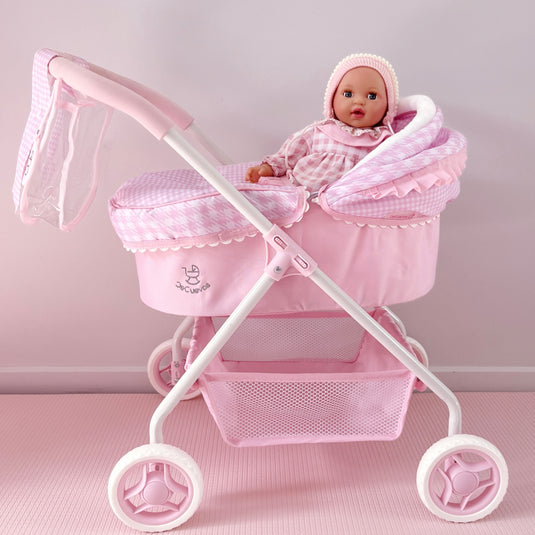A Biased View of Dolls And Accessories
A Biased View of Dolls And Accessories
Blog Article
Things about Dolls And Accessories
Table of ContentsThe 20-Second Trick For Dolls And AccessoriesThe 6-Second Trick For Dolls And AccessoriesThe Buzz on Dolls And AccessoriesNot known Facts About Dolls And AccessoriesDolls And Accessories Things To Know Before You Get ThisThe Ultimate Guide To Dolls And AccessoriesThe Basic Principles Of Dolls And Accessories
When dolls are consisted of in team play, kids practice waiting, sharing, and paying attention to others' ideas. Whether they're acting to be a moms and dad, brother or sister, or pal, youngsters find out just how connections workhow to sustain others, solve differences, and look after somebody else. These very early role-play experiences end up being the foundation for healthy friendships and connections later in life.Repeating comforting routines with a doll (feeding, rocking, placing to bed) can aid kids really feel tranquil and safe and secure. Taking care of a doll can make a child really feel qualified and certain.
Not known Details About Dolls And Accessories
When youngsters see dolls that reflect their race, heritage, and society, it strengthens a positive sense of identification. Dolls likewise introduce youngsters to cultures outside their own, developing considerate interest and empathy for others.
As Dr. Karyn Purvis, a leader in kid advancement and trauma-informed care, when stated: This powerful quote highlights exactly how play isn't just funit's exactly how youngsters find out ideal. The brain cables itself with repeating. When a youngster is involved, happy, and psychologically linked to an activitylike doll playthe mind strengthens those connections quicker and much more meaningfully.
Dolls And Accessories - Truths

Children require compassion, kindness, and imagination tooand doll play provides that. Yesdolls supply something one-of-a-kind. They motivate flexible storytelling and emotional connection in a manner couple of other playthings do. Dolls are frequently a child's initial "pal," aiding them practice partnerships, develop communication abilities, and really feel comforted. Children establish their sense of self from a young age.
Facts About Dolls And Accessories Revealed
With dolls that matter. Samantha Ong Samantha Ong is the founder of Joeydolls, a Canadian-based plaything brand name on a goal to commemorate Asian societies through joyous, comprehensive play. Influenced by her very own experiences expanding up without social representation, Samantha designs dolls that aid kids feel pleased of who they are while triggering interest and empathy in others.
Playing with dolls urges children to talk even more regarding others' thoughts and emotions, a research study has actually discovered. The study suggests that playing fictional games with dolls could help kids create social abilities, theory of mind and compassion.
8 Easy Facts About Dolls And Accessories Shown
They were likewise a lot more most likely to attend to the dolls in the second individual, talking with them directly, whereas the characters on the computer system screen they had a tendency to refer to in the third individual. No distinction was observed in between boys and women."Interior state language can suggest that a kid is thinking concerning other individuals's thoughts and feelings while having fun with dolls," claimed Gerson.
And that they see language usage in this regard is excellent confirmation of the hypothesis."Mardell included that the searchings for ought to apply to any kind of kind of role-play toy, rather than being particular to Barbies."Children normally begin to show indications of internal state language around the age of four.
How Dolls And Accessories can Save You Time, Stress, and Money.
"It becomes important for making and maintaining relationships, and exactly how they pick up from their instructors, and parents."The study additionally found that the children had actually increased brain task in the posterior exceptional temporal sulcus (pSTS) region when they talked as though their dolls had ideas and read sensations. The pSTS region is thought to be associated with the development of social and emotional processing abilities.
Youth is not a static life phase; certainly, the interpretation, significance and understanding of childhood are all based on alteration. By the nineteenth century among the most extensive adjustments was the value positioned on allowing youngsters to experience "the care free delights" of childhood via play activities. Play was currently taken into consideration to be an essential component of an excellent youth.
In order to totally comprehend the definition of play, one must additionally understand the significance of the doll. Nevertheless, dolls are much even more than playthings made to amuse young ladies. During the 19th century proper playtime tasks were chosen to advertise intellectual, physical or emotional development. Dolls were particularly prominent since they were believed to foster and support womanly top qualities such as compassion, caring and empathy.
6 Simple Techniques For Dolls And Accessories

It is only via archaeological investigations that researchers can hope to reveal and document the full series of playtime experiences. Chronicling these experiences, and specifically the function of dolls, is essential for offering a much more full image of childhood years throughout the nineteenth century. Alarcn, Sara E - baby dolls., "Child's Play: The Duty of Dolls in 19th Century Childhood Years" (2007 )
Report this page